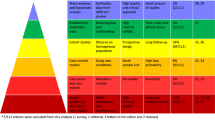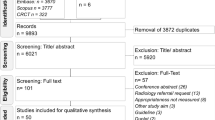Abstract
We raise a problem of applicability of RCTs to validate nuclear diagnostic imaging tests. In spite of the wide application of PET and other similar techniques that use radiopharmaceuticals for diagnostic purposes, RCT-based evidence on their validity is sparse. We claim that this is due to a general conceptual problem that we call Prevalence of Treatment, which arises in connection with designing RCTs for testing any diagnostic procedure in the present context of medical research, and is particularly apparent in this case. We also identify three practical reasons why RCTs do not qualify as the best option for PET validation, which have to do with specific characteristics of nuclear diagnostic imaging, and of radiopharmaceuticals. The paper is meant to contribute both to the philosophical discussion on the EBM hierarchy of evidence, and on the specific debate on radiopharmaceuticals in nuclear medicine.
Similar content being viewed by others
Notes
There are many accuracy studies in the literature, that compare FDG PET-CT with standard diagnostic tests in specific areas (See e.g. Czernin et al. 2013 for a review).
Other factors, alternative to treatment, that may intervene in the causal chain from test to clinical benefit are change in time-frame of management (i.e. speeding up decisions), and alterations of patients’ and clinicians’ perception of the situation. Such factors are even more difficult to measure with an RCT than test-plus-intervention clinical benefit (Di Ruffano and Deeks 2016).
Arguably, there are cases in which PET can have a direct clinical benefit, namely when it replaces an invasive procedure like surgical staging. Is it possible to design a RCT to assess the direct clinical benefits of nuclear medicine imaging techniques, in such cases? Yes, but it would not be necessary, and therefore not appropriate, as the positive clinical (avoidance of the invasive procedure) is immediate, and there is no need to monitor the two groups of patients (invasive versus non-invasive procedure) over time. Here, the characteristics of RCTs methodology make them not recommendable (Vach et al. 2011).
We are not claiming that the Predominance of treatment problem is generalizable a priori to all diagnostic tests. That there is a Predominance of treatment problem, derives from the requirement that medical diagnostic tests are evaluated at least partially in terms of their clinical benefit, which is a contingent feature of current healthcare and scientific regulative practices Therefore, it is surely possible that no such problem (mutatis mutandis) arises with other diagnostic tests, e.g. in engineering or robotics. We thank an anonymous reviewer for this point.
As suggested by a reviewer of this Journal, a possible direction of inquiry could be on the possibility of qualifying or partially suspending the Principle of Equipoise, either when applied to tests on diagnostic procedures, and not on treatments, or when research is conducted with the declared aim of providing treatment. This suggestion deserves to be discussed on a separate paper.
For a philosophical discussion of consensus conferences, see Solomon (2007).
References
Biesheuvel CJ, Grobbee DE, Moons KGM (2006) Distraction from randomization in diagnostic research. Ann Epidemiol 16:540–544
Bluhm R (2016) Evidence, meta-analysis, and systematic review. In: Solomon M, Simon J, Kincaid H (eds) The Routledge companion to philosophy of medicine. Routledge, Oxford
Carne X, Arnaiz JA (2000) Methodological and political issues in clinical pharmacology research by the year 2000. Eur J Clin Pharmacol 55:781–785
Charlton BG, Miles A (1998) The rise and fall of EBM. QJM 12:371–374
Clarke M, Hopewell S, Chalmers I (2007) Reports of clinical trials should begin and end with up-to-date systematic reviews of other relevant evidence: a status report. J R Soc Med 100:187–190
Clarke B, Gillies D, Illari P, Russo F, Williamson J (2014) Mechanisms and the evidence hierarchy. Topoi 33(2):339–360
Czernin J, Allen-Auerbach M, Nathanson D, Herrmann K (2013) PET/CT in Oncology: Current Status and Perspectives. Curr Radiol Rep 1:177–190
Di Ruffano LF, JJ Deeks (2016) Test-treatment RCTs are sheep in wolves’ clothing (Letter commenting on: J Clin Epidemiol. 2014;67:612–21). J Clin Epidemiol 69:266–267
Dubois B, Feldman HH, Jacova C et al (2013) Advancing research diagnostic criteria for Alzheimer’s disease: the IWG-2 criteria. Lancet Neurol 13(6):614–629
Freedman B (1987) Equipoise and the ethics of clinical research. N Engl J Med Overseas Ed 317:141–145
Friedman LM, Furberg CD, DeMets DL (1998) Fundamentals of clinical trials, 3rd edn. Springer, New York
Fryback DG, Thornbury JR (1991) The efficacy of diagnostic imaging. Med Decis Making 11(2):88–94
Gambhir SS, Czernin J, Schwimmer J, Silverman DH, Coleman RE, Phelps ME (2001) A tabulated summary of the FDG PET literature. J Nucl Med 42(Suppl):1S– 93S
Glasziou P, Chalmers I, Rawlins M, McCulloch P (2007) When are randomised trials unnecessary? Picking signal from noise. BMJ 334(7589):349–363
Graham MM, Weber WA (2016) Evaluation of the efficacy of targeted imaging agents. J Nucl Med 57(4):653–659
Guyatt G (1991) Evidence-based medicine. ACP J Club A-16:114–119
Hastings J, Adams EJ (2006) Joint project of the international network of agencies for health technology assessment—part 1: survey results on diffusion, assessment, and clinical use of positron emission tomography. Int J Technol Assess Health Care 22:143–148
Hicks RJ, Hofman MS, Ware RE (2012) Not-so-random errors: randomized controlled trials are not the only evidence of the value of PET. J Nucl Med 53(11):1820–1822
Howick J (2011) The philosophy of evidence-based medicine. Wiley, Oxford
Ishii K (2014) PET approaches for diagnosis of dementia. AJNR 35:2030–2038
Ishimori T, Patel PV, Wahl RL (2005) Detection of unexpected additional primary malignancies with PET/CT. JNM 46(5):752–757
Landewé R, Van Der Heijde D (2007) Primer: challenges in randomized and observational studies. Nat Rev Rheumatol 3(11):661–666
Leeflang MM, Deeks JJ, Gatsonis C, Bossuyt PM (2008) Systematic reviews of test accuracy. Ann Intern Med 149(12):889–897
Lesaffre E, Verbeke G (2005) Clinical trials and intervention studies. In: Everitt B, Howell DC (eds) The encyclopedia of statistics in behavioral science. Wiley, New York
Lord SJ, Irwig L, Simes RJ (2006) When is measuring sensitivity and specificity sufficient to evaluate a diagnostic test, and when do we need randomized trials? Ann Intern Med 144(11):850–855
National Institute of Mental health (2014) Imaging predictors of treatment response in depression NCT00367341, Retrieved from https://clinicaltrials.gov/show/NCT00367341
Pearl J (2009) Causality. Cambridge University Press, New York
Quine WV (1953) From a logical point of view. Harvard University Press, Cambridge Mass
Rowe CC, Villemagne VL (2013) Amyloid imaging with PET in early Alzheimer disease diagnosis. Med Clin North Am 97(3):377–398
Sackett DL (2000) Evidence-based medicine: how to practice and teach EBM, 2nd edn. Churchill Livingstone, Edinburgh
Sackett DL, Rosenberg WM, Gray JA, Haynes RB, Richardson WS (1996) Evidence based medicine: what it is and what it isn’t. BMJ 312:71–72
Schilling LP, Zimmer ER, Shin M, Leuzy A, Pascoal TA, Benedet AL, Rosa-Neto P (2016) Imaging Alzheimer’s disease pathophysiology with PET. Dement Neuropsychol 10(2):79–90
Schober O, Riemann B (eds) (2012) Molecular imaging in oncology, vol 187. Springer Science & Business Media, Dordrecht
Schünemann AHJ, Oxman AD, Brozek J, Glasziou P, Jaeschke R et al (2008) Grading quality of evidence and strength of recommendations for diagnostic tests and strategies. BMJ 336:1106–1110
Sehon SR, Stanley DE (2003) A philosophical analysis of the evidence-medicine debate. BMC Health Serv Res 3:14–24
Siepe B, Hoilund-Carlsen PF, Gerke O, Weber WA, Motschall E, Vach W (2014) The move from accuracy studies to randomized trials in PET: current status and future directions. J Nucl Med 55(8):1228–1234
Siontis KC, Siontis GC, Contopoulos- Ioannidis DG, Ioannidis JP (2014) Diagnostic tests often fail to lead to changes in patient outcomes. J Clin Epidemiol 67(6):612–621
Smith GC, Pell JP (2003) Parachute use to prevent death and major trauma related to gravitational challenge: systematic review of randomised controlled trials. BMJ 327:1459–1461
Solomon M (2007) The social epistemology of NIH consensus conferences. In: Kincaid H, McKitrick J (eds) Establishing medical reality. Philosophy and Medicine, vol 90. Springer, Dordrecht
Soucy JP, Bartha R, Bocti C et al (2012) Clinical applications of neuroimaging in patients with Alzheimer’s disease: a review from the Fourth Canadian Consensus Conference on the Diagnosis and Treatment of Dementia. Alzheimers Res Ther 5(Suppl 1):S3
Syed YY, Deeks E (2015) [18F] Florbetaben: a review in β-Amyloid PET imaging in cognitive impairment. CNS Drugs 29(7):605–613
Ter Meulen R, Biller-Andorno N, Lenk C, Lie R (2005). Evidence-based practice in medicine and health care: a discussion of the ethical issues. Springer Science & Business Media, Dordrecht
Vach W, Hoilund-Carlsen PF, Gerke O, Weber WA (2011) Generating evidence for clinical benefit of PET/CT in diagnosing cancer patients. J Nucl Med 52(Supplement 2):77S–85S
Ware RE, Hicks RJ (2011) Doing more harm than good? Do systematic reviews of PET by health technology assessment agencies provide an appraisal of the evidence that is closer to the truth than the primary data supporting its use? J Nucl Med 52(Supplement 2):64S–73S
Weber WA (2011) Is there evidence for evidence-based medical imaging? J Nucl Med 52(Supplement 2):74S–76S
Woodward (2003) Making things happen: a theory of causal explanation. Oxford University Press, Oxford
Worrall J (2007) Why there’s no cause to randomize. Br J Philos Sci 58:451–488
Author information
Authors and Affiliations
Corresponding author
Rights and permissions
About this article
Cite this article
Lalumera, E., Fanti, S. Randomized Controlled Trials for Diagnostic Imaging: Conceptual and Pratical Problems. Topoi 38, 395–400 (2019). https://doi.org/10.1007/s11245-017-9535-z
Published:
Issue Date:
DOI: https://doi.org/10.1007/s11245-017-9535-z




